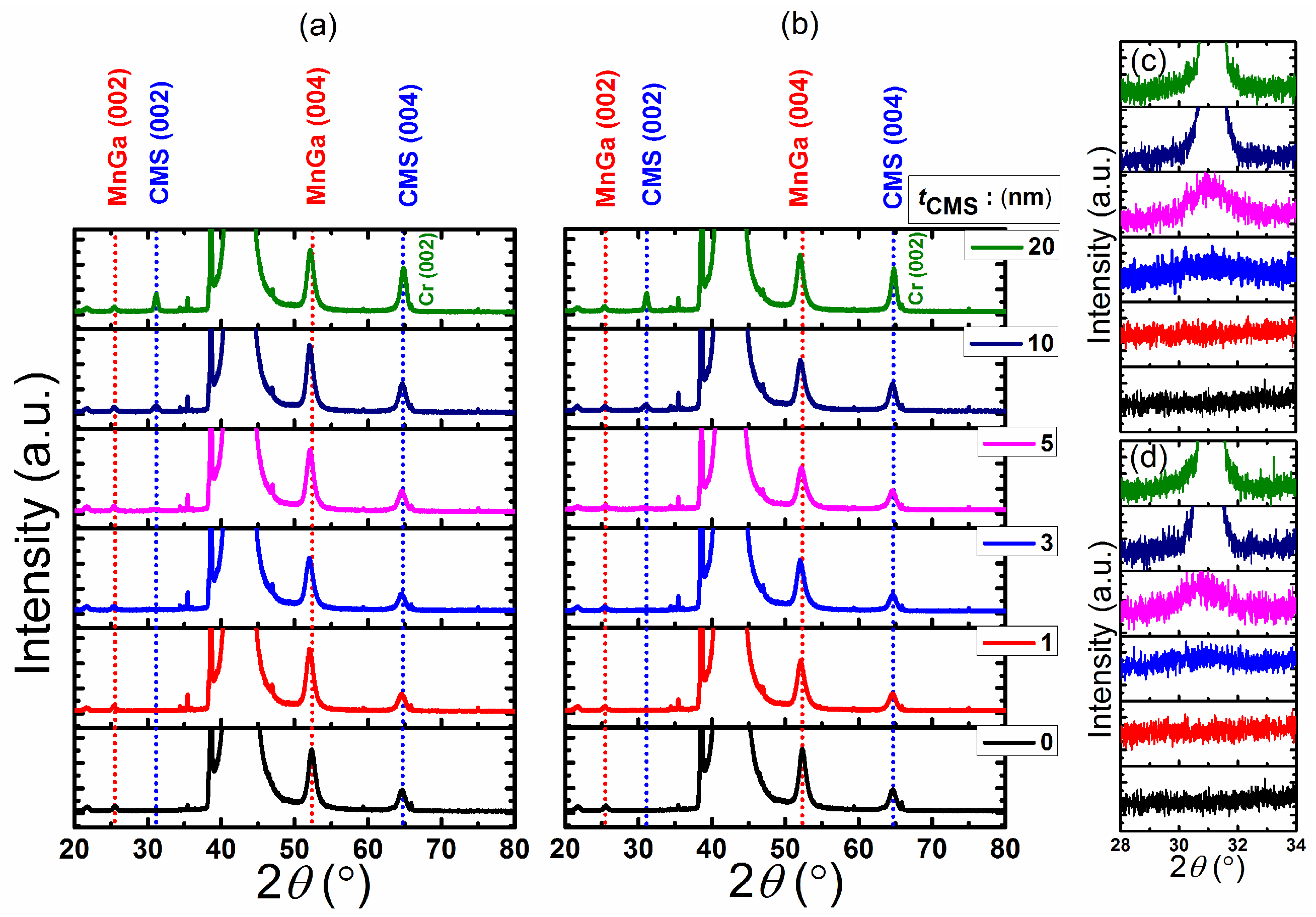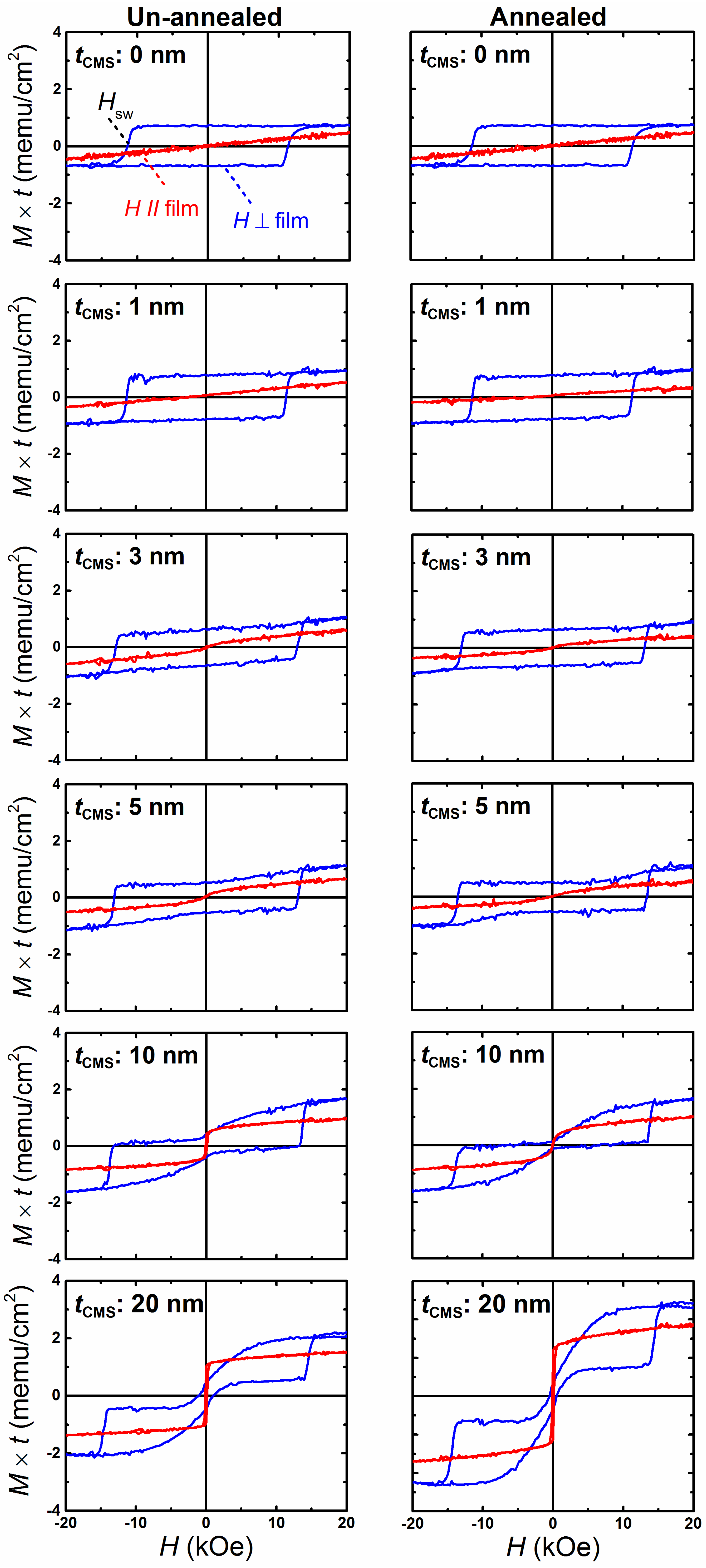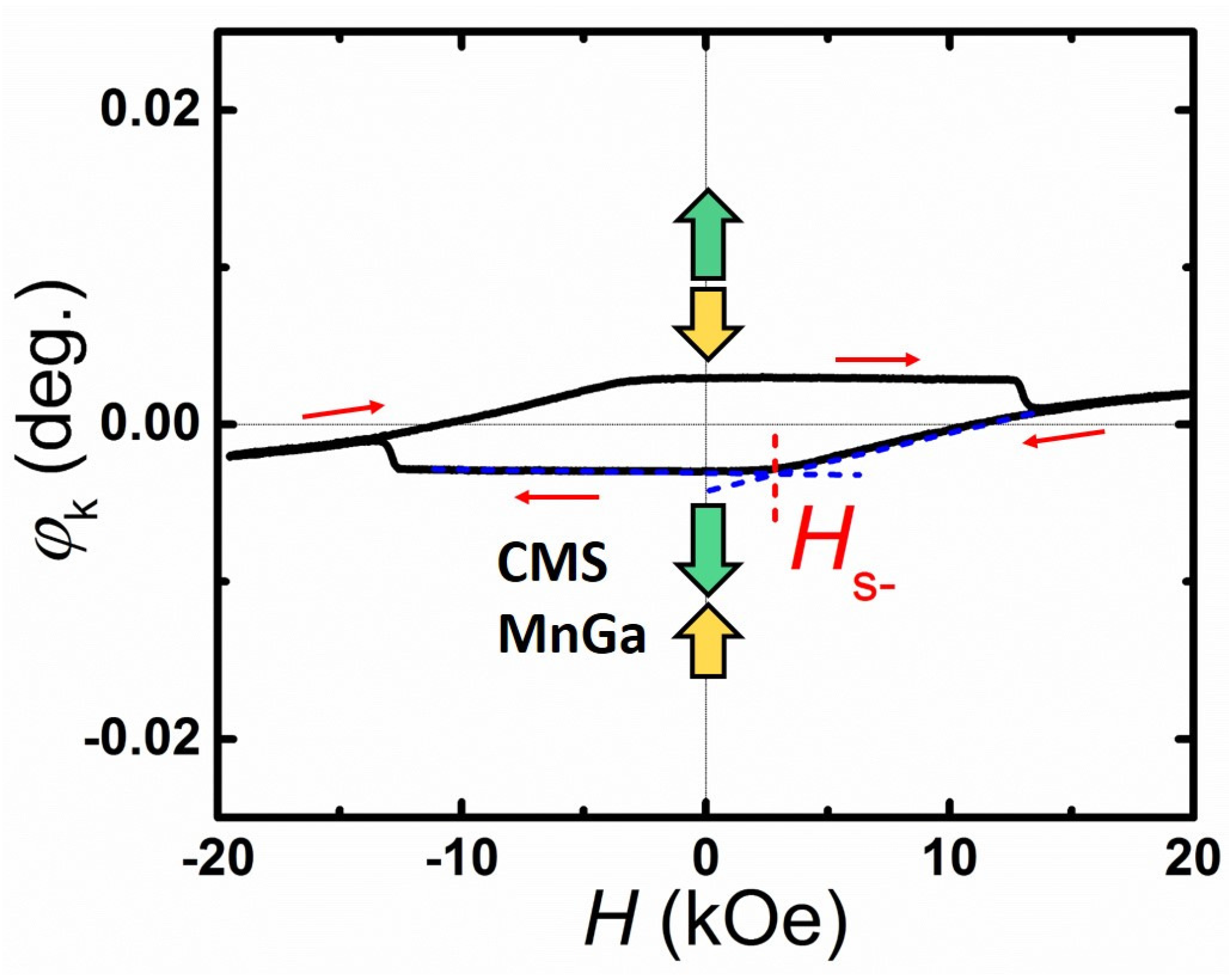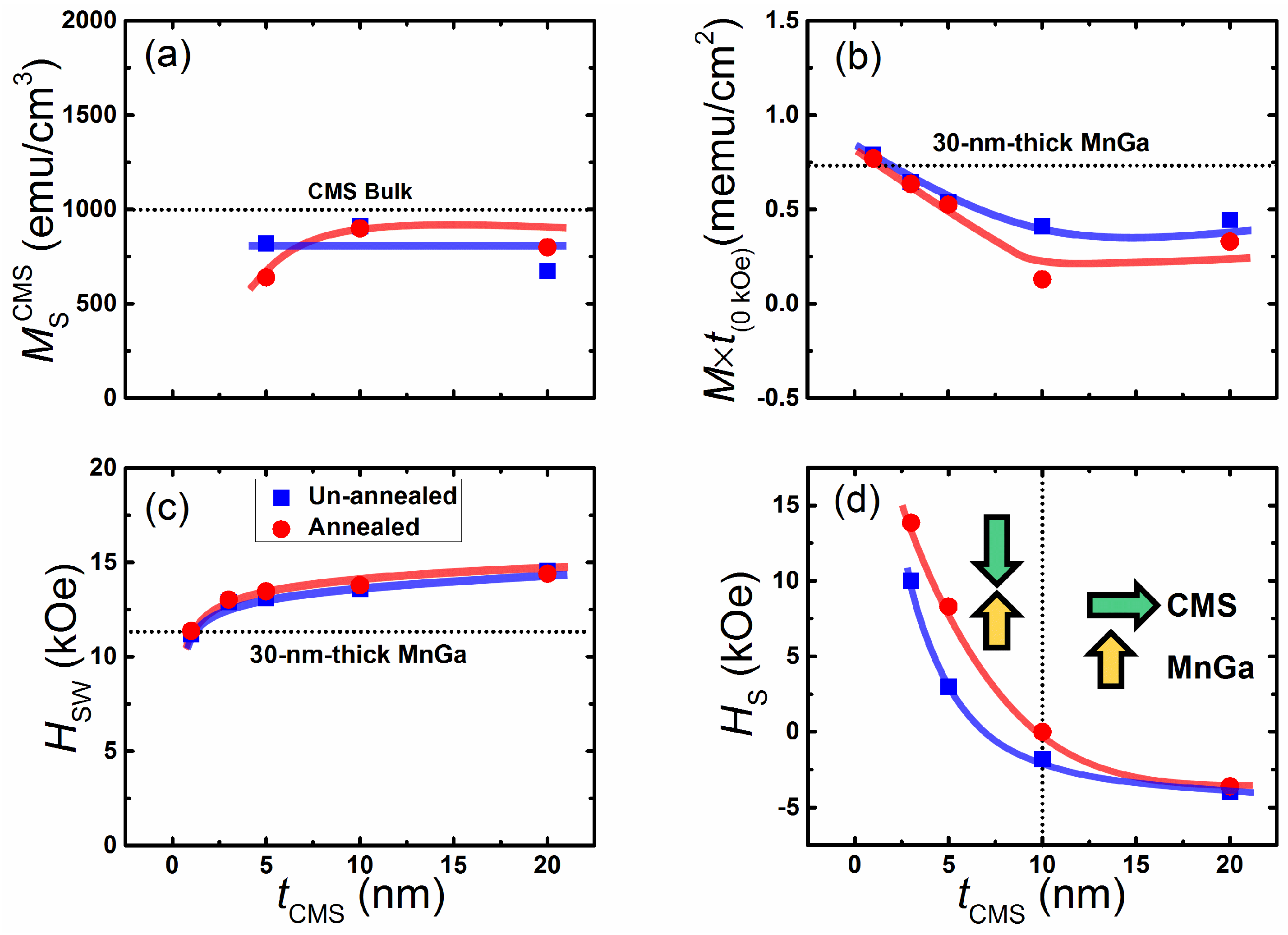Engineered Heusler Ferrimagnets with a Large Perpendicular Magnetic Anisotropy
Abstract
:1. Introduction
2. Experimental Design
3. Results and Discussion





4. Conclusions
Acknowledgments
Author Contributions
Conflicts of Interest
References
- Hiratsuka, T.; Kim, G.; Sakuraba, Y.; Kubota, T.; Kodama, K.; Inami, N.; Naganuma, H.; Oogane, M.; Nakamura, T.; Takanashi, K.; et al. Fabrication of perpendicularly magnetized magnetic tunnel junctions with L10-CoPt/Co2MnSi hybrid electrode. J. Appl. Phys. 2010, 107. [Google Scholar] [CrossRef]
- Yakushiji, K.; Fukushima, A.; Kubota, H.; Konoto, M.; Yuasa, S. Ultralow-Voltage spin-transfer switching in perpendicularly magnetized magnetic tunnel junctions with synthetic antiferromagnetic reference layer. Appl. Phys. Express 2013, 6, 113006. [Google Scholar] [CrossRef]
- Kishi, T.; Yoda, H.; Kai, T.; Nagase, T.; Kitagawa, E.; Yoshikawa, M.; Nishiyama, K.; Daibou, T.; Nagamine, M.; Amano, M.; et al. Lower-current and fast switching of a perpendicular TMR for high speed and high density spin-transfer-torque MRAM. In Proceedings of the IEEE International Electron Devices Meeting, San Francisco, CA, USA, 15–17 December 2008; pp. 1–4.
- Yoda, H.; Kishi, T.; Nagase, T.; Yoshikawa, M.; Nishiyama, K.; Kitagawa, E.; Daibou, T.; Amano, M.; Shimomur, N.; Takahashi, S.; et al. High efficient spin transfer torque writing on perpendicular magnetic tunnel junctions for high density MRAMs. Curr. Appl. Phys. 2010, 10, e87–e89. [Google Scholar] [CrossRef]
- Mizukami, S.; Kubota, T.; Wu, F.; Zhang, X.; Miyazaki, T.; Naganuma, H.; Oogane, M.; Sakuma, A.; Ando, Y. Composition dependence of magnetic properties in perpendicularly magnetized epitaxial thin films of Mn-Ga alloys. Phys. Rev. B 2010, 85. [Google Scholar] [CrossRef]
- Kurt, H.; Rode, K.; Venkatesan, M.; Stamenov, P.; Coey, J.M.D. High spin polarization in epitaxial films of ferrimagnetic Mn3Ga. Phys. Rev. B 2011, 83. [Google Scholar] [CrossRef]
- Balke, B.; Fecher, G.H.; Winterlik, J.; Felser, C. Mn3Ga, a compensated ferrimagnet with high Curie temperature and low magnetic moment for spin torque transfer applications. Appl. Phys. Lett. 2007, 90. [Google Scholar] [CrossRef]
- Feng, W.; Van Thiet, D.; Dung, D.D.; Shin, Y.; Cho, S. Substrate-modified ferrimagnetism in MnGa films. J. Appl. Phys. 2010, 108. [Google Scholar] [CrossRef]
- Wu, F.; Mizukami, S.; Watanabe, D.; Miyazaki, T.; Naganuma, H.; Oogane, M.; Ando, Y.; Miyazaki, T. Epitaxial Mn2.5Ga thin films with giant perpendicular magnetic anisotropy for spintronic devices. Appl. Phys. Lett. 2009, 94. [Google Scholar] [CrossRef]
- Bai, Z.; Cai, Y.; Shen, L.; Yang, M.; Ko, V.; Han, G.; Feng, Y. Magnetic and transport properties of Mn3−xGa/MgO/Mn3−xGa magnetic tunnel junctions: A first-principles study. Appl. Phys. Lett. 2012, 100. [Google Scholar] [CrossRef]
- Tanaka, M.; Harbison, J.P.; DeBoeck, J.; Sands, T.; Philips, B.; Cheeks, T.L.; Keramidas, V.G. Epitaxial growth of ferromagnetic ultrathin MnGa films with perpendicular magnetization on GaAs. Appl. Phys. Lett. 1993, 62, 1565–1567. [Google Scholar] [CrossRef]
- Van Roy, W.; Akinaga, H.; Miyanishi, S.; Tanaka, K.; Kuo, L.H. Epitaxial MnGa/(Mn, Ga, As)/MnGa trilayers: Growth and magnetic properties. Appl. Phys. Lett. 1996, 69, 711–713. [Google Scholar] [CrossRef]
- Liang, H.; Tao, L.L.; Liu, D.P.; Lu, Y.; Han, X.F. Spin dependent transport properties of Mn-Ga/MgO/Mn-Ga magnetic tunnel junctions with metal (Mg, Co, Cr) insertion layer. J. Appl. Phys. 2014, 115. [Google Scholar] [CrossRef]
- Ener, S.; Skokov, K.P.; Karpenkov, D.Y.; Kuz’min, M.D.; Gutfleisch, O. Magnet properties of Mn70Ga30 prepared by cold rolling and magnetic field annealing. J. Magn. Magn. Mater. 2015, 382, 265–270. [Google Scholar] [CrossRef]
- Mandru, A.O.; Diaz, R.G.; Wang, K.; Cooper, K.; Haider, M.; Ingram, D.C.; Takeuchi, N.; Smith, A.R. Heteroepitaxial growth and surface structure of L10-MnGa (111) ultra-thin films on GaN (0001). Appl. Phys. Lett. 2013, 103. [Google Scholar] [CrossRef]
- Köhler, A.; Knez, I.; Ebke, D.; Felser, C.; Parkin, S. Loss of anisotropy in strained ultrathin epitaxial L10 Mn-Ga films. Appl. Phys. Lett. 2013, 103. [Google Scholar] [CrossRef]
- Wang, K.; Lu, E.; Knepper, J.W.; Yang, F.; Smith, A.R. Structural controlled magnetic anisotropy in Heusler L10-MnGa epitaxial thin films. Appl. Phys. Lett. 2011, 98. [Google Scholar] [CrossRef]
- Kubota, T.; Miura, Y.; Watanabe, D.; Mizukami, S.; Wu, F.; Naganuma, H.; Zhang, X.; Oogane, M.; Shirai, M.; Ando, Y.; et al. Magnetoresistance effect in tunnel junctions with perpendicularly magnetized D022-Mn3−δGa electrode and MgO barrier. Appl. Phys. Express. 2011, 4. [Google Scholar] [CrossRef]
- Ma, Q.L.; Kubota, T.; Mizukami, S.; Zhang, X.M.; Naganuma, H.; Oogane, M.; Ando, Y.; Miyazaki, T. Magnetoresistance effect in L10-MnGa/MgO/CoFeB perpendicular magnetic tunnel junctions with Co interlayer. Appl. Phys. Lett. 2012, 101. [Google Scholar] [CrossRef]
- Kubota, T.; Ma, Q.; Mizukami, S.; Zhang, X.; Naganuma, H.; Oogane, M.; Ando, Y.; Miyazaki, T. Dependence of Tunnel Magnetoresistance Effect on Fe Thickness of Perpendicularly Magnetized L10-Mn62Ga38/Fe/MgO/CoFe Junctions. Appl. Phys. Express. 2012, 5. [Google Scholar] [CrossRef]
- Ma, Q.L.; Mizukami, S.; Kubota, T.; Zhang, X.M.; Ando, Y.; Miyazaki, T. Abrupt Transition from Ferromagnetic to Antiferromagnetic of Interfacial Exchange in Perpendicularly Magnetized L10-MnGa/FeCo Tuned by Fermi Level Position. Phys. Rev. Lett. 2014, 112. [Google Scholar] [CrossRef]
- Sakuraba, Y.; Hattori, M.; Oogane, M.; Ando, Y.; Kato, H.; Sakuma, A.; Miyazaki, T.; Kubota, H. Giant tunneling magnetoresistance in Co2MnSi/Al-O/Co2MnSi magnetic tunnel junctions. Appl. Phys. Lett. 2006, 88. [Google Scholar] [CrossRef]
- Liu, H.; Honda, Y.; Taira, T.; Matsuda, K.; Arita, M.; Uemura, T.; Yamamoto, M. Giant tunneling magnetoresistance in epitaxial Co2MnSi/MgO/Co2MnSi magnetic tunnel junctions by half-metallicity of Co2MnSi and coherent tunneling. Appl. Phys. Lett. 2012, 101. [Google Scholar] [CrossRef]
- Ranjbar, R.; Suzuki, K.; Sugihara, A.; Ma, Q.L.; Zhang, X.M.; Miyzaki, T.; Ando, Y.; Mizukami, S. Interfacial exchange coupling in cubic Heusler Co2FeZ (Z= Al and Si)/tetragonal Mn3Ga bilayers. J. Appl. Phys. 2015, 117. [Google Scholar] [CrossRef]
- Ranjbar, R.; Suzuki, K.; Sugihara, A.; Ma, Q.L.; Zhang, X.M.; Miyzaki, T.; Ando, Y.; Mizukami, S. Antiferromagnetic coupling in perpendicularly magnetized cubic and tetragonal Heusler bilayers. Mater. Lett. 2015, 160, 88–91. [Google Scholar] [CrossRef]
- Berkowitz, A.E.; Takano, K. Exchange anisotropy. J. Magn. Magn. Mater. 1999, 200, 552–570. [Google Scholar] [CrossRef]
- Asti, G.; Ghidini, M.; Pellicelli, R.; Pernechele, C.; Solzi, M.; Albertini, F.; Casoli, F.; Fabbrici, S.; Pareti, L. Magnetic phase diagram and demagnetization processes in perpendicular exchange-spring multilayers. Phys. Rev. B 2006, 73. [Google Scholar] [CrossRef]
- Kobayashi, T.; Tsuji, H.; Tsunashima, S.; Uchiyama, S. Magnetization process of exchange-coupled ferrimagnetic double-layered films. Jpn. J. Appl. Phys. 1981, 20, 2089–2095. [Google Scholar] [CrossRef]
- Aharoni, A. Exchange anisotropy in films, and the problem of inverted hysteresis loops. J. Appl. Phys. 1994, 76, 6977–6979. [Google Scholar] [CrossRef]
- Yang, J.; Kim, J.; Lee, J.; Woo, S.; Kwak, J.; Hong, J.; Jung, M. Inverted hysteresis loops observed in a randomly distributed cobalt nanoparticle system. Phys. Rev. B 2008, 78. [Google Scholar] [CrossRef]
- Tsunegi, S.; Sakuraba, Y.; Oogane, M.; Takanashi, K.; Ando, Y. Large tunnel magnetoresistance in magnetic tunnel junctions using a Co2MnSi Heusler alloy electrode and a MgO barrier. Appl. Phys. Lett. 2008, 93. [Google Scholar] [CrossRef]
- Sakuraba, Y.; Izumi, K.; Iwase, T.; Bosu, S.; Saito, K.; Takanashi, K.; Miura, Y.; Futatsukawa, K.; Abe, K.; Shirai, M. Mechanism of large magnetoresistance in Co2MnSi/Ag/Co2MnSi devices with current perpendicular to the plane. Phys. Rev. B 2010, 82. [Google Scholar] [CrossRef]
© 2015 by the authors; licensee MDPI, Basel, Switzerland. This article is an open access article distributed under the terms and conditions of the Creative Commons Attribution license (http://creativecommons.org/licenses/by/4.0/).
Share and Cite
Ranjbar, R.; Suzuki, K.; Sugihara, A.; Miyazaki, T.; Ando, Y.; Mizukami, S. Engineered Heusler Ferrimagnets with a Large Perpendicular Magnetic Anisotropy. Materials 2015, 8, 6531-6542. https://doi.org/10.3390/ma8095320
Ranjbar R, Suzuki K, Sugihara A, Miyazaki T, Ando Y, Mizukami S. Engineered Heusler Ferrimagnets with a Large Perpendicular Magnetic Anisotropy. Materials. 2015; 8(9):6531-6542. https://doi.org/10.3390/ma8095320
Chicago/Turabian StyleRanjbar, Reza, Kazuya Suzuki, Atsushi Sugihara, Terunobu Miyazaki, Yasuo Ando, and Shigemi Mizukami. 2015. "Engineered Heusler Ferrimagnets with a Large Perpendicular Magnetic Anisotropy" Materials 8, no. 9: 6531-6542. https://doi.org/10.3390/ma8095320




